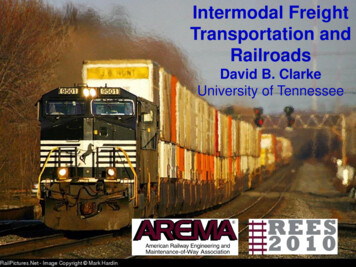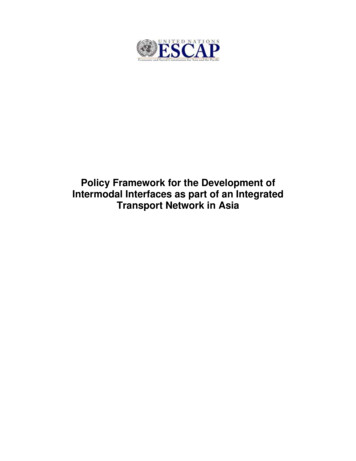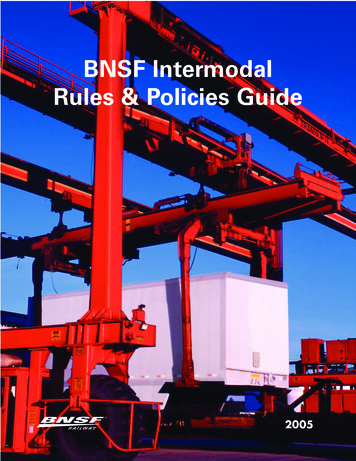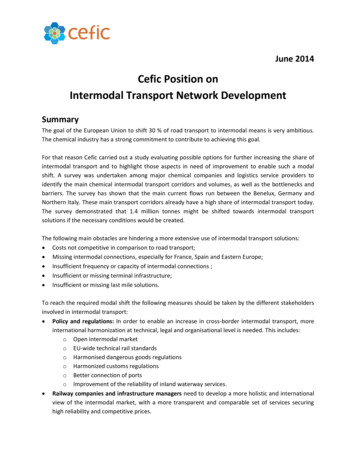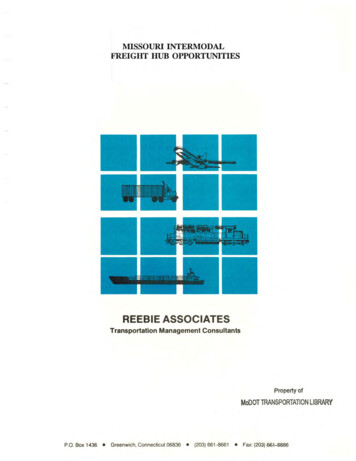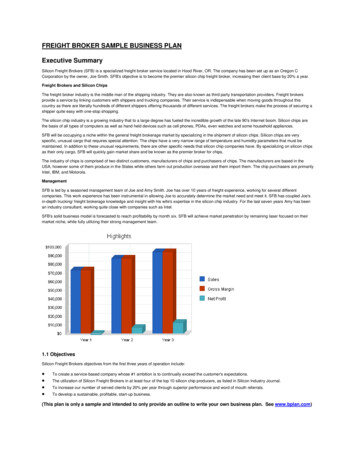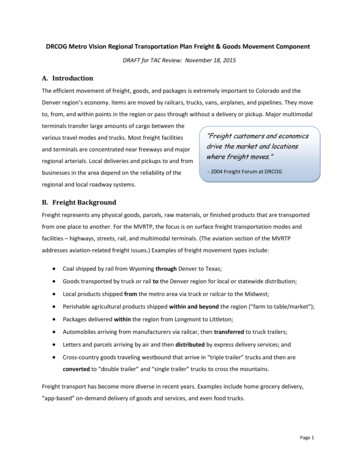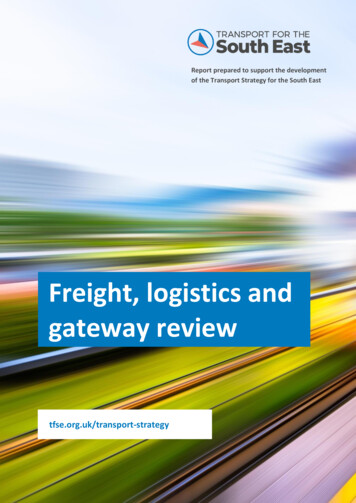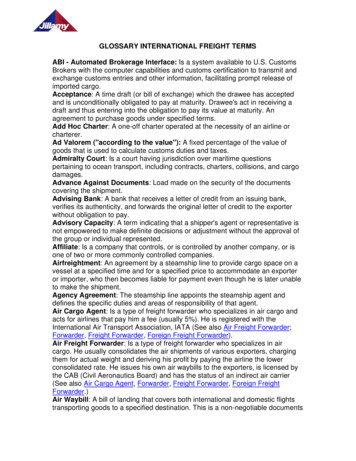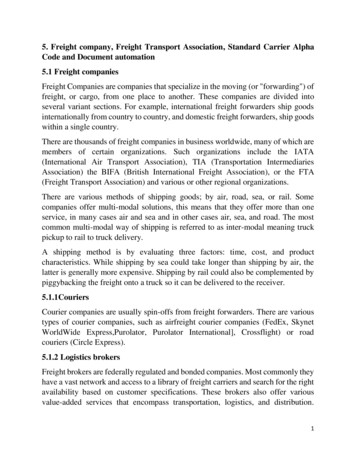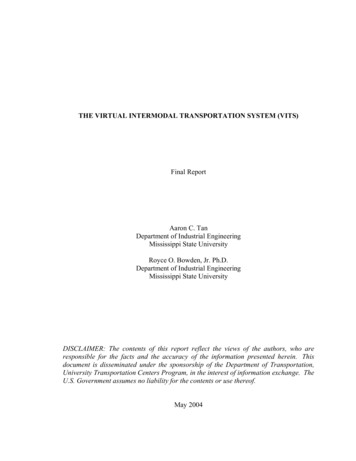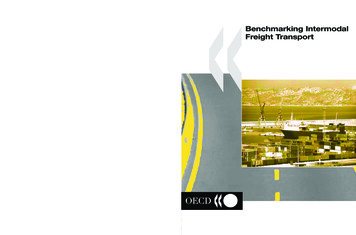
Transcription
«Benchmarking Intermodal Freight TransportBenchmarking IntermodalFreight TransportWhat is efficient intermodal freight transport? How are "best practices" to be found? What measuresare being developed in OECD countries for assessing the relative efficiency of modes and modalcombinations? What opportunities exist to improve complex intermodal transport chains? How aresuch opportunities identified and assessed?Today’s highly competitive global market calls for intermodal transport systems that meet industry’sexpectations in efficiency and reliability as well as government’s sustainability expectations. Whilebenchmarking is a tool for achieving such objectives, how are these benchmarking exercises bestimplemented? This report analyses illustrative benchmarking exercises to provide insights into theseimportant questions.This book is available to subscribers to the following SourceOECD theme:TransportAsk your librarian for more details of how to access OECD books online, or write to us atSourceOECD@oecd.orgwww.oecd.orgISBN 92-64-19742-777 2002 03 1 P-:HSTCQE V \YW]:Benchmarking Intermodal Freight TransportOECD's books, periodicals and statistical databases are now available via www.SourceOECD.org, our online library.
Benchmarking IntermodalFreight TransportORGANISATION FOR ECONOMIC CO-OPERATION AND DEVELOPMENT
ORGANISATION FOR ECONOMIC CO-OPERATIONAND DEVELOPMENTPursuant to Article 1 of the Convention signed in Paris on 14th December 1960, and which came intoforce on 30th September 1961, the Organisation for Economic Co-operation and Development (OECD)shall promote policies designed:– to achieve the highest sustainable economic growth and employment and a rising standard ofliving in Member countries, while maintaining financial stability, and thus to contribute to thedevelopment of the world economy;– to contribute to sound economic expansion in Member as well as non-member countries in theprocess of economic development; and– to contribute to the expansion of world trade on a multilateral, non-discriminatory basis inaccordance with international obligations.The original Member countries of the OECD are Austria, Belgium, Canada, Denmark, France,Germany, Greece, Iceland, Ireland, Italy, Luxembourg, the Netherlands, Norway, Portugal, Spain,Sweden, Switzerland, Turkey, the United Kingdom and the United States. The following countriesbecame Members subsequently through accession at the dates indicated hereafter: Japan(28th April 1964), Finland (28th January 1969), Australia (7th June 1971), New Zealand (29th May 1973),Mexico (18th May 1994), the Czech Republic (21st December 1995), Hungary (7th May 1996), Poland(22nd November 1996), Korea (12th December 1996) and the Slovak Republic (14th December 2000). TheCommission of the European Communities takes part in the work of the OECD (Article 13 of the OECDConvention).Publié en français sous le titre :Transport intermodal de marchandisesUNE ÉVALUATION COMPARATIVE OECD 2002Permission to reproduce a portion of this work for non-commercial purposes or classroom use should be obtainedthrough the Centre français d’exploitation du droit de copie (CFC), 20, rue des Grands-Augustins, 75006 Paris,France, tel. (33-1) 44 07 47 70, fax (33-1) 46 34 67 19, for every country except the United States. In the United Statespermission should be obtained through the Copyright Clearance Center, Customer Service, (508)750-8400,222 Rosewood Drive, Danvers, MA 01923 USA, or CCC Online: www.copyright.com. All other applications forpermission to reproduce or translate all or part of this book should be made to OECD Publications, 2, rue André-Pascal,75775 Paris Cedex 16, France.
FOREWORDThe mission of the OECD Programme of Research on Road Transport and Intermodal Linkages(RTR) is to promote economic development in its Member countries by enhancing transport safety,efficiency and sustainability through a co-operative research programme on road and intermodaltransport. To achieve this objective, the Programme recommends options for the development andimplementation of effective transport policies for Members, and encourages outreach activities fornon-member countries. All 30 Member countries participate in the Programme.The 1998-2000 Programme included a mandate for the establishment of an Intermodal FreightTransport Advisory Group. The Intermodal Freight Transport Advisory Group is examining key topicsfocusing on critical aspects of the role of governments in promoting intermodal transport including: Institutional aspects. Benchmarking intermodal freight transport performance. Urban freight logistics. International freight corridor development.These topics are being addressed in sequence. This report on Benchmarking Intermodal FreightTransport represents the second output of the Intermodal Freight Transport Advisory Group,following the 2001 report on Intermodal Freight Transport: Institutional Aspects. It is published onthe responsibility of the Secretary-General of the OECD.3
ABSTRACTIRTD NUMBER: E112021The global marketplace requires integrated, intermodal transport systems. An important issue indealing with this challenge is to assess which mode or modal combination, including transfer points,offers the “best” overall level of performance. Benchmarking is an instrument which can help answerthis question. It aims to improve performance by identifying best practices, analysing the reasons fordifferences in performance and suggesting potential changes that could be introduced by decisionmakers.The issue of identifying appropriate benchmarks that could be applied to assess the relativeefficiency of transport chains was investigated by the Intermodal Freight Transport Advisory Group,which was established by the Steering Committee for the Programme of Research on Road Transportand Intermodal Linkages (RTR) in 1998. This is the second report prepared by the Group, followingits 2001 report Intermodal Freight Transport: Institutional Aspects.The report summarises the outcomes of the analysis of benchmarks studied and used in OECDMember countries, and provides recommendations to policy makers for conducting effectivebenchmarking exercises to improve system performance.Field classificationEconomic and administration; environment; traffic and transport planning.Field codes10; 72.KeywordsDecision process; economic efficiency; economics of transport; evaluation(assessment); freight transport; intermodal transport (freight); logistics;OECD.4
TABLE OF CONTENTSExecutive Summary. 7Chapter 1. Introduction . 13Chapter 2. Issues in Benchmarking. 21Chapter 3. Benchmarks to Assess the Performance of the Transport Chain. 29Chapter 4. Development of Benchmarking Methods for Comparisonsof the Relative Efficiency of Modes. 43Annex 1. Intermodal Freight Transportation Advisory Group. 75Annex 2. Glossary of Abbreviations and Terms . 77Annex 3. Performance Indicators in Canada. 79Annex 4. Performance Indicators in the Czech Republic . 91Annex 5. Transport in Central and Eastern European Countries . 103Annex 6. Performance Indicators in Finland . 107Annex 7. Performance Indicators in Japan. 123Annex 8. Performance Indicators in the Netherlands. 127Annex 9. Performance Indicators in the United Kingdom. 1335
EXECUTIVE SUMMARYBackgroundThe Organisation for Economic Co-operation and Development (OECD) has an ongoingcommitment to freight-related transport research. The Programme of Research on Road Transport andIntermodal Linkages (RTR) for the 1998-2000 period had three key elements: Multimodal transport strategies. Economic performance, transport infrastructure and management. Sustainable development.The RTR Steering Committee established the Intermodal Freight Transport Advisory Group toinvestigate four topics: Institutional aspects of intermodal transport. Benchmarking and system performance measures. Economic and fiscal instruments. International freight corridor development.Each of the above topics is being addressed in sequence. Work on the subject of institutionalaspects has been completed, and the conclusions have been published in OECD (2001), IntermodalFreight Transport: Institutional Aspects.The overall focus of the work on “benchmarking” is centred on comparing the relative efficiencyof modes, modal combinations and modal interfaces. Government policy makers (along with transportindustry and logistics service providers) have an interest in the efficiency (including time, cost andreliability), safety and sustainability of transport systems, although at a more aggregate level than theprivate sector. The Working Group was asked to develop a vision for intermodal transport and toidentify appropriate benchmarks that could be applied to assess the relative efficiency of modes/modalcombinations and intermodal transfers, and to identify sources of inefficiency that could contribute tomodal choice.In line with the original intent of the project, the benchmarking analysis also seeks to developpolicy options for governments to address impediments to intermodal transport efficiency,encompassing institutional aspects, technology, including the role of intelligent transportation systems(ITS) and infrastructure. As such, the focus is on organisational aspects, from a government public7
policy perspective, rather than on the performance of industry players. The conclusions should be seenas a guide to improving system performance, rather than a regulatory framework.This report summarises the outcomes of the following tasks, with contributions from each of theMember countries that were associated with the Working Group: A review of studies on benchmarking and the available data. An analysis of benchmarks used in Member countries to assess the performance of modes,modal combinations and the performance of ports and terminals at the modal interface. An analysis of benchmarks currently applied by Member countries to key transport corridorsand commodities. A compendium of benchmarking studies available in Member countries. A summary of benchmarking methodologies.Each of the four studies undertaken by the Advisory Group uses the following definition as abaseline for intermodal transport:Intermodalism implies the use of at least two different modes of transport in anintegrated manner in a door-to-door transport chain.While the concept of intermodalism encompasses all freight movements involving two or moremodes of transportation, the principal focus in this study was on movement of non-bulk andcontainerised freight.OverviewThe global marketplace requires integrated, intermodal, single-waybill transport chains. Animportant issue in dealing with this challenge is to assess which mode or modal combination is thebest. Benchmarking is an instrument which can help to answer this question.Differences in the performance of various modes within the transport sector of a given country,and between the transport systems of different countries, imply that there is a significant potential forimprovement. Ongoing technological advances and changes in institutional approaches ensure that thispotential is constantly evolving. The transportation sector is influenced and moulded by ongoingeconomic, environmental and political (usually in the form of public finances) pressures to realise itspotential for improvement.Benchmarking has been identified as a tool for identifying potential improvements in thetransport sector. It aims to improve performance by identifying best performance and best practices,analysing the reasons for differences and suggesting potential changes that could be implemented bydecision makers.The decision makers, or target groups, of these efforts include policy makers, infrastructure andfacility operators, shippers and transport operators. Each of these target groups is a unique, but at thesame time, essential component of the overall integrated transportation system. As such, each target8
group has its own motivation for employing tools such as benchmarking to identify potentialimprovements in the transport sector.Lessons learnedAnalysis of existing benchmarking studies has shown that different benchmarking methods areused for different purposes. The methods chosen depend on the stakeholders and their objectives forconducting the benchmarking exercise, since different objectives require different indicators.Governments are responsible for national transportation and intermodal policy. Policy makerswant to know if the direction they are proceeding along is the right one, how their policies affect thedevelopment of intermodal transport and how they compare to other countries. Included in theseconsiderations is the support of economic growth, facilitation of the competitive position of nationalcarriers in a global market, improved efficiency leading to decreased cost, and the reduction ofenvironmental and social costs.Facility operators, such as terminal and other infrastructure operators, aim to operate asefficiently as possible. Benchmarking offers an opportunity to compare the efficiency, service leveland cost of their operations to similar services offered by other operators on a national andinternational scale.Shippers make their choices based on the relative performance of the different transport modes.Factors such as cost, transit time, reliability and services offered influence their choices. Comparativeanalysis allows shippers to make sound decisions, based on their needs and priorities.Transport operators need to know how their performance compares to other transportationcompanies. In an era of global competitiveness and pressure from environmental and social concerns,companies are increasingly interested in identifying, adopting and implementing recognised “bestpractices”.In conducting benchmarking exercises, care needs to be taken when drawing conclusions fromsuch applications, for two reasons. First, both supply chains and interactions between transportpolicies and other driving forces of transport demand are becoming increasingly complex, and second,there are limitations to availability of relevant and comparable data.Global supply chains involving intermodal transport are longer, more complex and inherentlymore expensive. In a just-in-time environment, all stakeholders are intent on identifying more efficientand productive approaches to reduce transport costs and eliminate impediments to improvedefficiency. Comparative analysis and the identification of best practices is one tool to achieve thisobjective.Transport benchmarking has to take into consideration the complexity and interactions betweentransport policy and the other driving forces between transportation supply and demand. This is acomplex scenario even when the analysis is limited to national and individual modal scenarios. Whendealing with intermodal transportation in an international context, the complexity of the interactions issubstantially magnified.Benchmarking studies are limited in scope by the availability of data, in particular data that arestandard across the facilities or modes on which the comparative analysis is being made. Policy9
makers, and other decision makers, must ensure that the conclusions drawn from a benchmarkingexercise reflect the limitations of the information and the approach used.Analysis of existing benchmarking studies has shown that methodologies for benchmarking haveyet to be fully developed. The actual application of these methodologies is at the experimental stage,particularly in terms of benchmarking performances of holistic supply chains, due to the complexitiesof the supply chains and limitations in data availability.The existing studies also show that there are many measurement issues to be resolved. In additionto the limitations of data availability, aggregated benchmark results, which are often used in suchstudies, can be misleading since changes in important factors may be buried in the aggregationprocess.It was encouraging to find that benchmarking exercises that were conducted under theco-operation of relevant stakeholders could be regarded as successful examples.RecommendationsOne of the many difficulties in benchmarking intermodal activities is that the limits of theintermodal transport chain are not clearly defined. Policy makers wishing to use benchmarking as atool should ensure that the objectives and scope of the exercise are clearly defined. This will help inensuring that conclusions, and development of future policy, correctly reflect the true outcome of thebenchmarking exercise.The choice of indicators is crucial for benchmarking exercises. Policy makers must ensure thatindicators which are most appropriate for the objectives and scope of the exercise are used, althoughthe availability and reliability of the data must also be taken into account.Given the complexity of benchmarking intermodal transport chains, shipper surveys couldprovide valuable insight into the overall performance of such systems by identifying “what aspects aremost important to the shipper”. Benchmarking of these “aspects” to assess relative performance acrosstransport chains could assist the development of transport policy by laying the foundation forperformance improvement.Benchmarking is one of many tools that can be used in the development of transport, andintermodal, policies. The complexity of the interactions between transport policy and the other drivingforces influencing the supply and demand of transportation services must also be known, understoodand taken into account.Benchmarking exercises are often most effective when comparing similar activities (for example,gantry crane operations at two ports). Benchmarking may also be successful when comparing largerscale operations of similarity (for example, Class I rail freight service in two or more countries). It isimportant to note that when using aggregate indicators such as, for example, tonne-kilometres orrevenue passenger kilometres, there are numerous micro-level indicators that make up the aggregateindicator. The methodology may not be capable of addressing how best to improve micro-levelperformance of the elements that comprise an intermodal chain.To be effective, benchmarking should focus on the expected outcomes of the comparativeanalysis. In order to improve performance, emphasis needs to be placed on “how to” addressunderlying differences between the “home” organisation and the performance of its “competitor”. A10
10% shift in own performance may fall short of ensuring competitiveness if efficiency levels continueto be below those attained by other operators in the marketplace. Attention should be paid to selectingkey performance indicators for which data can be collected, and which have relevance to theorganisation’s outcomes. In undertaking benchmarking of transport activities, it is important thatprimary stakeholders be involved in the exercise, both in the identification of the indicators and in theanalysis of factors contributing to lack of performance, including those requiring action bygovernments.Policy makers mus
The Intermodal Freight Transport Advisory Group is examining key topics focusing on critical aspects of the role of governments in promoting intermodal transport including: Institutional aspects. Benchmarking intermodal freight transport performance. Urban freight logistics. International freight corridor development.
